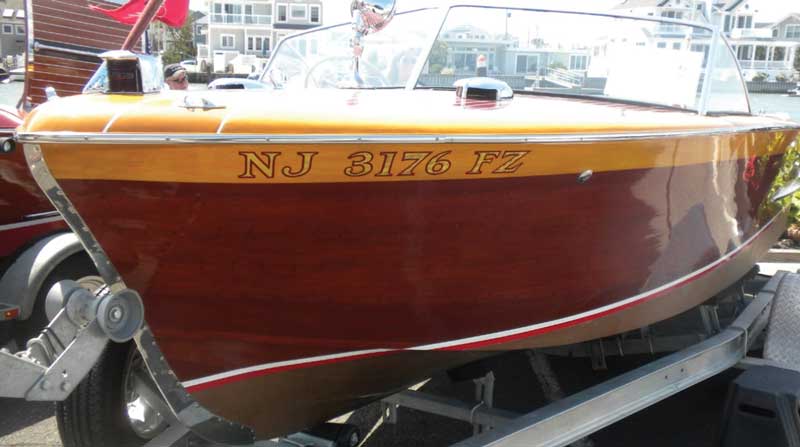I was invited aboard Liquid Asset, a Chris-Craft Holiday, by Ed Andrews, the boat’s owner and president of the Antique and Classic Boat Society (ACBS) Mid-Atlantic Chapter. I had a chance to experience her spirted ride on the Antique and Classic Boat Society’s Delaware River cruise.

Ed was the second owner of this runabout when he purchased it in 1992. The seller was the original owner who bought it brand new from Chris-Craft.
She is Chris-Craft hull number H–19–027. The “H” refers to the Holiday model name, “19” represents her 19-foot length, and the “27” confirms that she’s the 27th boat of this model built that year. Ed’s runabout is one of 107 Holiday models produced that year. She is a 1951 Holiday, powered by a KLC model Chris-Craft engine.
This wooden boat has had four restorations over time. The first two were authorized by the prior owner: The first restoration was undertaken by an unknown shop, and the second was done by a shop in the Adirondacks that is no longer in business.
After Ed took ownership, the third restoration was handled by Katz Marina on Lake Hopatcong in New Jersey. Planks and Power Boat Restoration in Wantage, NJ, was the latest shop to work on her, although this fourth effort was primarily a refresh of the varnish on her hull.

Let’s take a ride ourselves right now into some of the history about Chris-Craft. Gar Wood, the most famous racer, started his winning ways on the water with the purchase from Chris Columbus in 1916, which had become a successful Gold Cup racer. After a similar race, this boat was described as “a broken, battered hulk, fit only for junk” when it was put up for sale by Chris Smith, 53, who at that time was down to seven cents in his pockets after losing a poker game. Gar paid for this “battered hulk” with a $1000 down payment and a note for $800.
That racer, Miss Detroit, was built from a design by Joseph Napoleon “Nap” Lisee, who worked for Chris Smith’s C.C. Smith Boat and Engine Company. Right after buying the boat and engine of Miss Detroit in 1916, Gar Wood went to the Smith factory and bought controlling interest in it at an undisclosed price. Garwood saw the investment as a way to minimize the number of competitors racing against him once they knew that the talent of Chris Smith, his sons Jay and Bernard, and of course “Nap” were all involved. As a result, the Smith factory was then renamed the Gar Wood/C. C. Smith Boat and Engine Co.
Next, Gar Wood decided to build Miss Detroit II, a new race boat, using the 250-hp engine from the original hulk of Miss Detroit. That new boat set a speed record of 61.724 mph while racing the next year.
In 1921, Gar Wood ended his ownership in the company and returned it to 100 percent ownership by the Smith family. In 1922, it was renamed again, this time as the Chris Smith and Sons Boat Co. Then in 1930, the family named it the Chris-Craft Corporation, which was retained until it was acquired by NAFI (National Automotive Fibers Inc).
Let’s take a closer look now at the structure Chris-Craft used to build its runabouts. Batten seam construction means that each plank has a smaller piece (the “batten”) that backs up each plank seam along the full length of the boat. So, the planks are fastened not only to the boat’s frames but also to the battens. The only exception to this process in the Chris-Craft line of runabouts was the Cavalier series.
Batten construction is extremely strong, yet still relatively light compared to double plank boats. So, it enabled single planked boats to be built with thinner planks.
The durability of Chris-Craft’s technique with batten seam construction and long-term endurance was a winning solution. Although their boats were often the price leaders, they were also the most popular of the wooden boat builders. As a result, Chris-Craft achieved a great deal of success and was the leader in production volume among all wooden boat builders for many years.
By Chris "Seabuddy" Brown